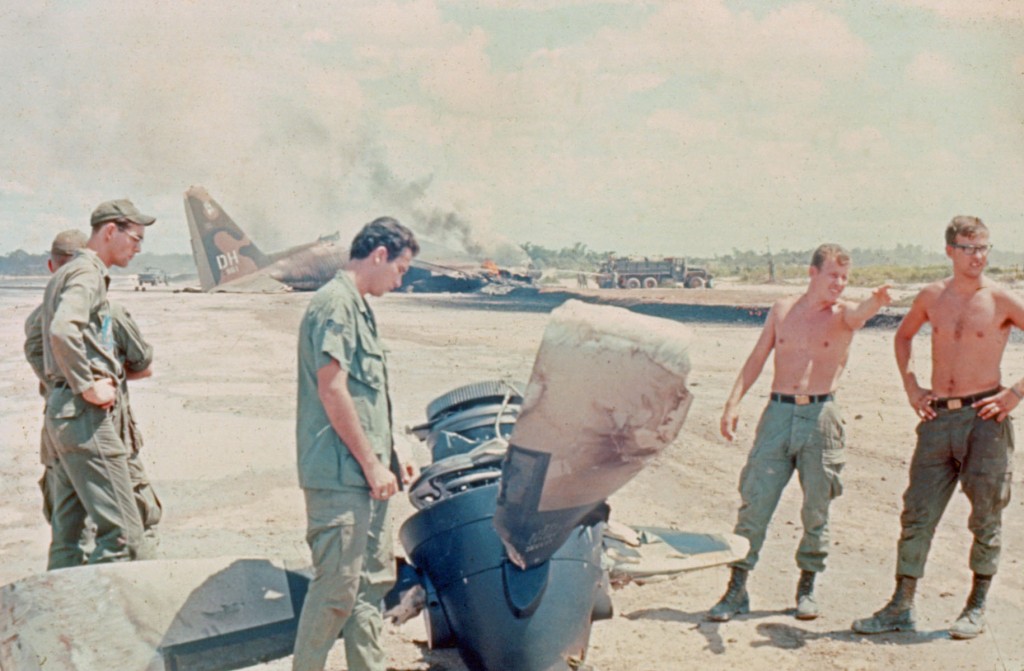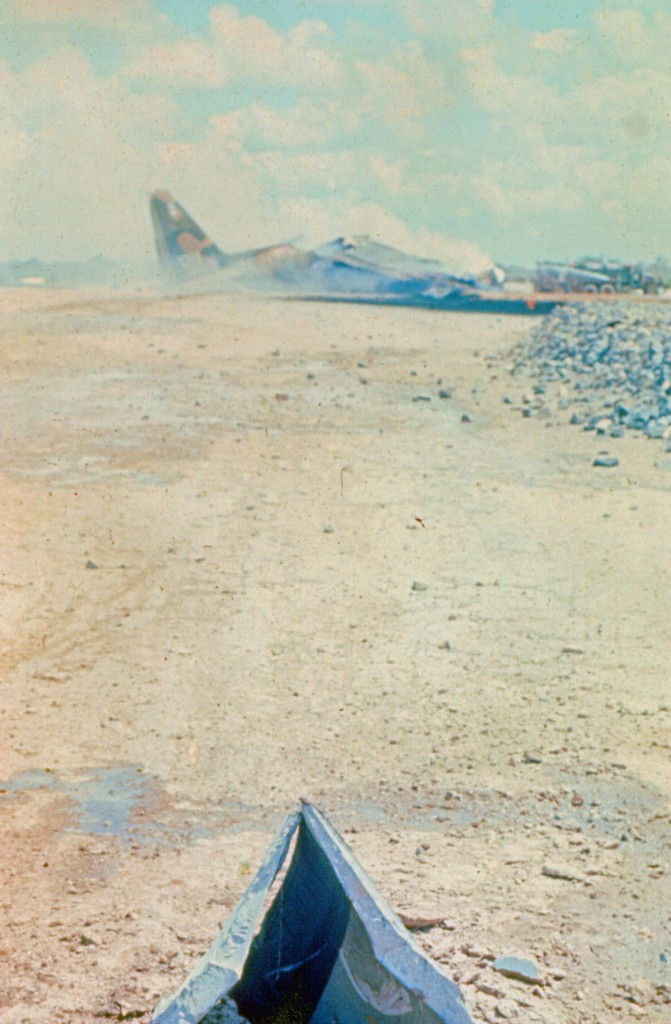Fire in Flight – Page 14.
At some point, the USAF or DoD began to add Explosion Suppresant Foam (ESF) to the fuel tanks of the C-130 aircraft, perhaps as a result (in part) of our shootdown and the B model loss a year later. I'm not sure exactly when this started, but I do know that the H models, beginning around 1984 or 1985, were manufactured with the blue foam included, and the total volume of fuel went from 9,680 gals. to 9,248 gals., a reduction of about 4.5%, which you would expect.

Fig. 27 - This is either the #3 or #4 prop that was lost as the right wing contacted the runway. Aircraft in the background.
During the Iraq war, a British C-130 was shot down near Baghdad on 30 January 2005. All 10 on board perished. The aircraft was hit at low altitude, its right wing caught on fire and subsequently exploded. Following is an exerpt from the UK Ministry of Defense (MOD) report on the incident:
"This explosion caused the outboard section of the wing to separate from the rest of the wing at which point the aircraft immediately became uncontrollable."
Later in the report, while discussing probable causes:
"The lack of fuel tank fire inerting system may have contributed to the loss of the aircraft. We are now exploring the procurement and fitting of a suitable fire inerting system as a matter of urgency."
And from Air Chief Marshall Sir Jock Stirrup, head of the Royal Air Force, "It is clear that the aircraft was shot down by hostile fire. The crew did all they should, and all that we would expect of such brave and professional airmen. But they faced a combination of circumstances that, alas, no one could overcome."
It is my understanding that only one aircraft in the British C-130 fleet had the ESF installed at the time. I would expect that they all have it now.
So the question remains, does the blue foam only prevent an explosion or does it also prevent or mitigate a fire in the tank? We know that fuel vapor explodes when ignited, but if you can displace the air in the tank ullage (the space above the fuel), by either inserting the foam or pumping in an inert gas, you can eliminate the danger of an explosion. What about a fire? I think a fuel fire is a product of an ignition source (e.g., an incendiary round) and a source of fuel vapor. So, first the tank has to be ruptured; the fuel spilling from the rupture must then come in contact with the ignition source. To the extent that the foam limits the spillage, perhaps it also mitigates the fire. It is important to remember that it is not the fuel that burns, it's the fuel vapor.
It has been suggested to me that perhaps our wing fire was actually a hydraulic-fluid fire (MIL-5606). That perhaps a flap actuator or its plumbing was hit, and the 5606, which is highly flammable, caught on fire. This may very well have been the case, initially. But, if so, it spread quickly to the fuel that had apparently been spilling from a wing tank rupture. I would expect that just a few gallons of 5606 would have been present, not nearly enough to have sustained such a fire as we had.
There have been many instances in Vietnam where rounds penetrated fuel tanks on the C-130. This happened to a member of my own crew, and they were able to fly the aircraft home with fuel pouring out of the hole.
So what happens when an incendiary round penetrates a fuel tank without the blue foam present? My guess is that, if there is fuel vapor above the fuel, it would explode. If the tank were full, the chance of an explosion is lessened, but perhaps you would have a fire at the point where the spilling fuel vaporizes and comes in contact with the entry point of the round. On a tank with the foam present, the fire would be somewhat limited because one of the purposes of the foam is to prevent sloshage (if I can coin a word), in other words, the tendency for fuel to slosh or move about the tank. This property would presumably limit the rate of leakage or spillage of the fuel, much like a sponge soaks up water.
I think it is safe to say that ESF is well worth its added weight and cost--and the 4.5% volume penalty--when weighed against the benefits of its added fire and explosion suppression, especially in the combat environment.
